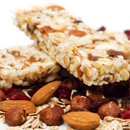 There are so many bars available to consumers today – nutrition bars, energy bars, meal replacement bars, etc. – it can be overwhelming and confusing to know which one you should buy (if any!). As people try to reduce the amount of junk food that they consume they may be looking at bars as an alternative. The bar business is a multi-billion dollar market in North America – no wonder consumers are confused!
There are so many bars available to consumers today – nutrition bars, energy bars, meal replacement bars, etc. – it can be overwhelming and confusing to know which one you should buy (if any!). As people try to reduce the amount of junk food that they consume they may be looking at bars as an alternative. The bar business is a multi-billion dollar market in North America – no wonder consumers are confused!
Are Snack Bars Actually Just Junk Food?
Advertisement
A recent report from Packaged Facts examined this multi-billion bar industry and looked at 2 categories – cereal/granola bars and energy/nutrition bars. They site numerous reasons why the bar industry is booming including: new product launches, improved marketing to different consumers as well as a continued improvement in delivery formats. The report also points out that eating trends are continually changing and favor the bar industry. These changing eating habits include: a blurring between meals and snacks, a strong emphasis on portion size for control of calories, as well as informal, spontaneous eating. All of these factors favor the bar industry as grabbing a bar is an easy, on-the-go bite to eat.
The bar industry itself is also blurring the line between cereal/granola bars and energy/nutrition bars. Changes are continually being made to make cereal/granola bars more nutritious by adding functional ingredients such as protein or fiber. Manufacturers of cereal/granola bars are starting to shift from “treats” (which some say is junk food) to a nutritious snack or even a meal replacement bar. Bars that have seen good growth rates include those labeled as high-protein, low-carbohydrate or balance-gastrointestinal formulations. The changes being made to the cereal/granola bar industry are more than likely going to have a negative impact on the sale of energy/nutrition bars because people will shift from pricier energy/nutrition bars to cheaper, multi-pack cereal/granola bars.
Snack Bars Could Mean Calories and Sugar – Be Careful What You Buy
On the other hand, energy/nutrition bars are trying to improve the flavor of their bars to make them more appealing to the consumer. Additionally, to differentiate the energy/nutrition bar from the cereal/granola bar manufacturers are using Coenzyme Q10, L-carnitine, omega-3, resveratrol and Vitamin K2, which may carry additional health benefits that cannot be obtained from eating a cereal/granola bar.
Advertisement
While people may reach for a bar at various times, a vast amount of people opt for energy bars before they exercise. These bars typically claim that they are a great snack before you exercise. However, if you look at the packaging, you may be surprised to find out that they are often packed with added sugar which means an increased number of calories. A typical energy bar contains a high level of sugar (15-20 grams per 2 ounces) and can contain over 300 calories. If you’re going to participate in exercise in an attempt to lose weight, perhaps reaching for that energy bar that’s packed with calories before you exercise is not the best idea. Instead, reach for fresh fruits and vegetables prior to your exercise routine for an energy boost. Fruits and vegetables packed with vitamins and minerals and are low in calories and will help you get through your exercise routine.
Bottom line – if you’re looking to lose weight, regular exercise and a healthy balanced diet (and cutting out junk food) is the best way to reduce calories and drop excess weight. If you are going to reach for a bar, be sure to read the nutrition label to make sure that you’re not consuming glorified junk food in the form of a bar packed with calories.
